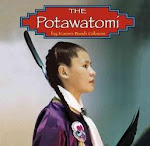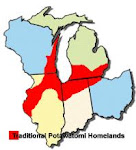Life fairly rough in the 1960-1990s
by
Life on the reservation
Poverty on the reservation was in a similar condition as when many Vietnam veterans had left, and it too had worsened. The reservation was a classic example of how the wartime expenditures had affected the domestic program of the United States. Jane Priwer, a writer, gave a vivid description of the reservation condition in the 1970s: "They are not in good shape today. Their reservation is a desolate place, splintered by unpaved, muddy roads and inhabited by only a few of the oldest and poorest members of the tribe. The rest are in the cities. Average income is about $2,500 a year, unemployment around 50% and the high school drop out rate 44 percent."
In addition, the tribal government had a $6,450 budget for the year of 1972. This low sum was supposed to be enough to govern the affairs of the tribe. All of these financial figures translated into a period of abject poverty for the tribe, but not much different than the rest of the country. The United States and the reservation were all feeling the backlash of Vietnam, a war that cost $150 billion.
While this analysis of the tribal financial condition was true, the reservation was home, and, as so many times in the past, the tribal members made the best of the situation. Tribal members worked in the surrounding towns and cities in construction fields, packing houses, garden nurseries and whatever temporary employment was available.
In some family situations, as many as 12 children lived in a small four-room house with no running water. But those homes were relatively happy, and food was always available. It was a dire neccessity for the children to leave home at an early age, so it was not uncommon for young people to get married at the age of 18 or 19 and move into apartments in the surrounding towns and cities like Holton or Topeka. Marriages usually lasted a long time because there was no room back home if it didn't work out.
Potawatomi learned self-sufficiency at a young age because of the economics of the times. But the reservation was always home, and young couples often came home to visit or attend social events.
Grim statistics showed the Potawatomi had a death rate about twice as high as the state average and a birth rate three times the state average as well as an infant mortality rate two times the average during this period. Dr. Patricia Schlosser, who worked in the children's clinic in Holton, noted how the infant mortality rate is one of the most sensitive indexes of the general health of a people. Another physician who worked with the tribe said the life expectancy was only 43 years of age. He said many Indians in the area had major nutritional problems.
Elizebeth Munoz stated, "Indians have every problem that the ethnic and low income person has plus their own cultural problems, including a sense of pride. It's harder in many cases to admit they do need help.
Where the average tribal member benefited the most was the new housing that came to the reservation in the late 1970's. The Department of Housing and Urban development authorized the building of 36 homes in a housing site. A few were built on scattered sites. In time, a total of over 90 homes were built on the reservation. Housing was desperately needed for the growing population. Yet there was opposition to this concept.
In the 1960s and early 1970s, many tribal members looked upon the new housing as another ploy to get the land. It was a fear that tribal members would be evicted for non-payment of rent (based on income), and non-Indians would then move in and own the tribal land. It was a justifiable fear, but that did not transpire. Federal housing programs on many reservations have been resented because the houses are planned on the basis of Western values-geometric lots, houses close together and no place for animals while the Indian people strongly prefer their own traditional housing patterns, houses scattered over the land just within hailing distance or homes designed for small clusters of related families. This pattern was rooted deeply in the history of the tribe.
On the positive side, the new houses meant coming home to the reservation and no longer having to live in surrounding communities where discrimination was an accepted fact. Now the people had the opportunity to live among their families and friends. Yet, it was close to a self imposed segregation.

To read more Mitchell's Link
About Gary Mitchell Link
shawnosh@yahoo.com
In some family situations, as many as 12 children lived in a small four-room house with no running water. But those homes were relatively happy, and food was always available. It was a dire neccessity for the children to leave home at an early age, so it was not uncommon for young people to get married at the age of 18 or 19 and move into apartments in the surrounding towns and cities like Holton or Topeka. Marriages usually lasted a long time because there was no room back home if it didn't work out.
Potawatomi learned self-sufficiency at a young age because of the economics of the times. But the reservation was always home, and young couples often came home to visit or attend social events.
Grim statistics showed the Potawatomi had a death rate about twice as high as the state average and a birth rate three times the state average as well as an infant mortality rate two times the average during this period. Dr. Patricia Schlosser, who worked in the children's clinic in Holton, noted how the infant mortality rate is one of the most sensitive indexes of the general health of a people. Another physician who worked with the tribe said the life expectancy was only 43 years of age. He said many Indians in the area had major nutritional problems.
Elizebeth Munoz stated, "Indians have every problem that the ethnic and low income person has plus their own cultural problems, including a sense of pride. It's harder in many cases to admit they do need help.
Where the average tribal member benefited the most was the new housing that came to the reservation in the late 1970's. The Department of Housing and Urban development authorized the building of 36 homes in a housing site. A few were built on scattered sites. In time, a total of over 90 homes were built on the reservation. Housing was desperately needed for the growing population. Yet there was opposition to this concept.
In the 1960s and early 1970s, many tribal members looked upon the new housing as another ploy to get the land. It was a fear that tribal members would be evicted for non-payment of rent (based on income), and non-Indians would then move in and own the tribal land. It was a justifiable fear, but that did not transpire. Federal housing programs on many reservations have been resented because the houses are planned on the basis of Western values-geometric lots, houses close together and no place for animals while the Indian people strongly prefer their own traditional housing patterns, houses scattered over the land just within hailing distance or homes designed for small clusters of related families. This pattern was rooted deeply in the history of the tribe.
On the positive side, the new houses meant coming home to the reservation and no longer having to live in surrounding communities where discrimination was an accepted fact. Now the people had the opportunity to live among their families and friends. Yet, it was close to a self imposed segregation.
To read more Mitchell's Link
About Gary Mitchell Link
shawnosh@yahoo.com
,+Karen+Bush+Gibson,+Ex-+-+eBay+(item+360233250981+end+time+Mar-09-10+19-22-27+PST)_1265816805474.jpeg)







































No comments:
Post a Comment